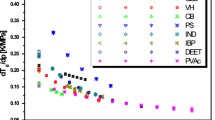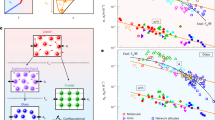Abstract
Classical description of thermodynamic properties during glass transition has been questioned by the entropy-loss model. The uncompensated loss of entropy at the glass transition temperature and zero residual entropy is at the heart of the controversy. Both the models are critically reviewed. A unified model is presented which incorporates features of both entropy loss and residual entropy. It implies two different types of contributions to the entropy of the supercooled liquid, one of which vanishes at the transition and the other which contributes to residual entropy. Entropy gain during spontaneous relaxation of glass, and the nature of heat capacity ‘hysteresis’ during cooling and heating through the glass transition range support the proposed model. Experiments are outlined for differentiating between the models.
Similar content being viewed by others
References
Angell C A and Torell L M 1983 J. Chem. Phys. 78 937
Balmakov M D 1996 J. Glass Phys. Chem. 22 344
Goetzberger A, Hebling C and Schock H W 2003 J. Mater. Sci. Eng. 40 1
Goldstein M 2008 J. Chem. Phys. 128 154510
Gupta P K and Mauro J C 2007 J. Chem. Phys. 126 224504
Gupta P K and Mauro J C 2008 J. Chem. Phys. 129 067101
Hikima T, Okamoto N, Hanaya M and Oguni M 1998 J. Chem. Thermodynamics 30 509
Johari G P 2000 J. Chem. Phys. 113 751
Johari G P 2010 Thermochim. Acta 500
Kauzmann W 1948 Chem. Rev. 43 219
Kivelson D and Reiss H 1999 J. Phys. Chem. B103 8337
Palmer R G 1982 J. Adv. Phys. 31 69
Papagiakoumou E, Papadopoulos D N and Serafetinides A A 2007 J. Opt. Commun. 276 80
Raoux S, Shelby R M, Sweet J J, Munoz B, Salinga M, Chen Y, Lai E K and Lee M H 2008 J. Microelectron. Eng. 85 2330
Reiss H 2009 J. Non-Cryst. Solids 355 617
Speedy R J 2003 Biophys. Chem. 105 411
Waseda Y 1980 The structure of non-crystalline materials (New York: McGraw-Hill International Book Co.)
Author information
Authors and Affiliations
Corresponding author
Rights and permissions
About this article
Cite this article
Jacob, K.T., Prabhudev, S. & Mallya, R.M. Resolution of conflicting views on thermodynamics of glass transition: A unified model. Bull Mater Sci 33, 603–609 (2010). https://doi.org/10.1007/s12034-010-0092-y
Received:
Published:
Issue Date:
DOI: https://doi.org/10.1007/s12034-010-0092-y




